3.5: The Geologic Time Scale
- Page ID
- 21453
The geological time scale is one of the crowning achievements of science, and geology in particular (Figure \(\PageIndex{1}\)). It is a reference and communication system for comparing rocks and fossils from throughout the world and is geology’s equivalent of the periodic table of the elements.

The geological time scale is currently maintained by the International Commission on Stratigraphy (ICS), which is part of the International Union of Geological Sciences. The time scale is continuously being updated as geoscientists learn more about the timing and nature of past geological events. You can view the ICS time scale online.
The geological time scale provides a global summary of countless small-scale temporal correlations of rock layers made at local and regional scales. It is based almost entirely upon careful observations of the distributions of fossils both geographically and stratigraphically. The dates were added much later following the advent of numerical dating techniques giving us the ability to bracket the ages of different organisms in relation to numerical dates provided by associated igneous activity. The simple Principle of Superposition and Principle of Faunal Succession have provided geologists with the ability to reconstruct the geological history of Earth by correlating rocks and fossils from different places. This is critically important because no single place on Earth preserves a complete geological history, or even a small fraction of it. We only get a sense of the full story if we look everywhere, using multiple locations to piece together the puzzle of snapshots of the Earth through time.
Organization of the geologic time scale
Because geologic time is so very long, the time scale has been subdivided into sections, much like we subdivide the yearly calendar into months, weeks and days or our day into hours, minutes and seconds. In the case of the geologic time scale, the component parts from largest to smallest are Eons, Eras, Periods, and Epochs (Figure \(\PageIndex{1}\)). The details of the geologic time scale are listed here; more details and descriptions follow in this section.
A Simplified Geologic Time Scale
-
Geologic Time 4.56 Ga to present
-
Phanerozoic Eon 541 Ma to present
-
Cenozoic Era 66 Ma to present
-
Quaternary Period 1.8 Ma to present
-
Holocene Epoch 11.8 Ka to present
-
Pleistocene Epoch 1.8 Ma to 11.8 Ka
-
-
Neogene Period 23 to 1.8 Ma
-
Pliocene Epoch 5.3 to 1.8 Ma
-
Miocene Epoch 23 to 5.3 Ma
-
-
Paleogene Period 66 to 23 Ma
-
Oligocene Epoch 34 to 23 Ma
-
Eocene Epoch 56 to 34 Ma
-
Paleocene Epoch 66 to 56 Ma
-
-
-
Mesozoic Era 252 to 66 Ma
-
Cretaceous Period 100 to 66 Ma
-
Jurassic Period 201 to 100 Ma
-
Triassic Period 252 to 201 Ma
-
-
Paleozoic Era 541 to 252 Ma
-
Permian Period 299 to 252 Ma
-
Carboniferous Period 359 to 299 Ma
-
Pennsylvanian Period 323 to 299 Ma
-
Mississippian Period 359 to 323 Ma
-
-
Devonian 419 to 359 Ma
-
Silurian 443 to 419 Ma
-
Ordovician 485 to 443 Ma
-
Cambrian 541 to 485 Ma
-
-
-
Precambrian (Group of Eons) 4.56 Ga to 541 Ma
-
Proterozoic Eon 2.5 Ga to 541 Ma
-
Archean Eon 4.0 Ga to 2.5 Ga
-
Hadean Eon 4.56 Ga to 4.0 Ga
-
-
Eons
The Eon is the broadest category of geological time. Earth’s history is characterized by four Eons; in order from oldest to youngest, these are the Hadean, Archean, Proterozoic, and Phanerozoic (Figure \(\PageIndex{2}\)). Collectively, the Hadean, Archean, and Proterozoic are sometimes informally referred to as the “Precambrian.” The Cambrian Period defines the beginning of the Phanerozoic Eon; so, all rocks older than the Cambrian are Precambrian in age.
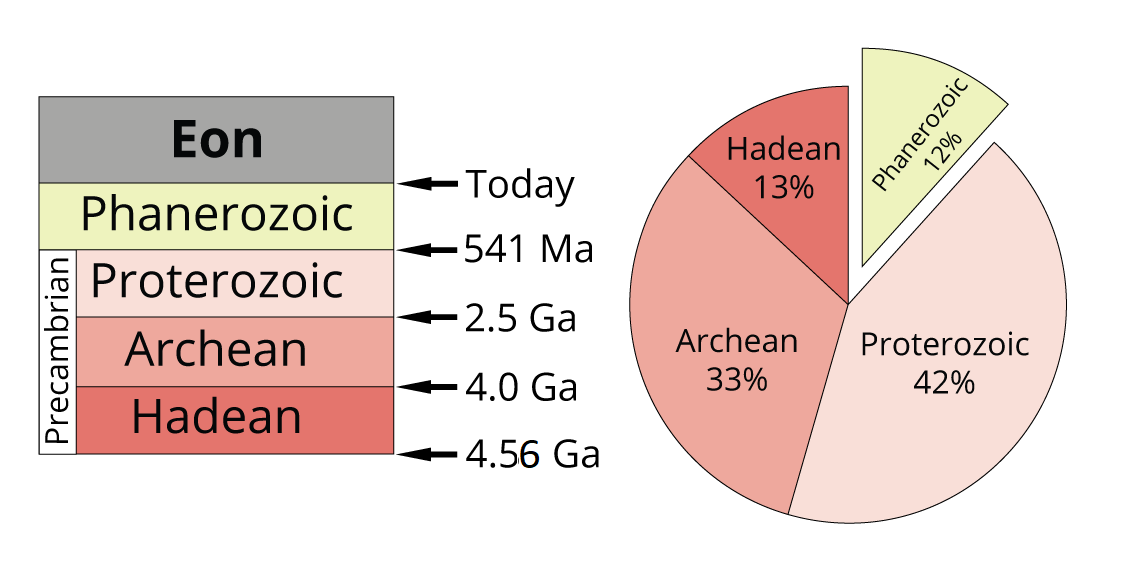
We live during the Phanerozoic, which means “visible life.” This is the interval of geological time characterized by abundant, complex fossilized remains. Being the youngest Eon of time, it is also very well represented by rock at Earth’s surface (because of the Principle of Superposition). Because of these two factors, most paleontologists and geologists study fossils and rocks from the Phanerozoic Eon.
Consider that Earth is roughly 4.56 billion years old. This age is based on the analysis of some of the oldest geological materials found so far. The Phanerozoic Eon began 541 million years ago (or, 0.541 billion years ago). Thus, the Phanerozoic Eon represents a paltry 12% of Earth’s history! Instead, most of Earth’s history is represented by the three Precambrian Eons. These older Eons tell the story of Earth’s beginning, life’s origin, and the rise of complex life.
This video is a good quick summary of the immensity of geologic time.
Eras
Eons of geologic time are subdivided into Eras, which are the second-longest units of geological time. The Phanerozoic Eon is divided into three Eras: the Paleozoic, Mesozoic, and Cenozoic (Figure \(\PageIndex{3}\)).
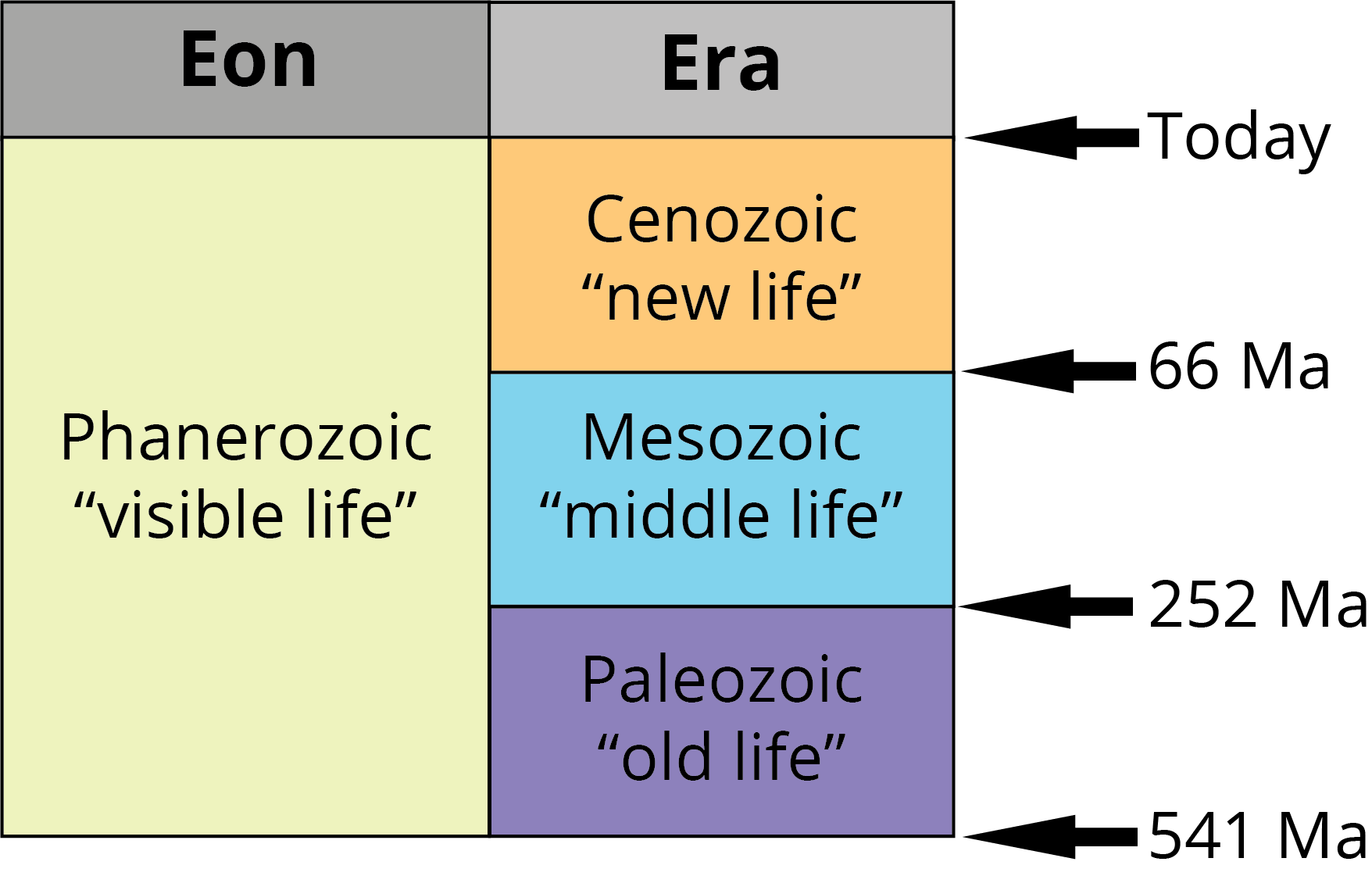
Most of our knowledge of the fossil record comes from the three eras of the Phanerozoic Eon. The Paleozoic (“old life”) Era is characterized by trilobites, the first four-limbed vertebrates, and the origin of land plants. The Mesozoic (“middle life”) Era represents the “age of dinosaurs,” though also is noteworthy for the first appearances of mammals and flowering plants. Finally, the Cenozoic (“new life”) Era is sometimes called the “age of mammals” and is the Era during which we live today.
As temporal points of reference, it is worth memorizing the ages of the boundaries that separate the three eras of the Phanerozoic Eon. Long before geologists knew these absolute age dates, they realized that the boundaries represent important events in the history of life: mass extinctions. For example, many fossils that are commonly found in the youngest Paleozoic rocks are not found in overlying Mesozoic rocks. Similarly, dinosaur fossils found in the youngest Mesozoic rocks are never again found in the overlying Cenozoic rocks. Paleontologists and geologists used these mass extinction events to define these (and other) boundaries within the Phanerozoic portion of the geological time scale. It is therefore no coincidence that some of the major boundaries coincide with mass extinction events!
The older Archean and Proterozoic Eons are similarly divided into several eras. For example, the youngest Era of the Proterozoic Eon is called the Neoproterozoic. For the sake of simplicity, these older eras are not included on the time scale shown at the top of this page; they do, however, exist!
Periods
Just as Eons are subdivided into eras, eras are subdivided into units of time called periods.
The Paleozoic Era is divided into six periods (Figure \(\PageIndex{4}\)). From oldest to youngest, these are the Cambrian, Ordovician, Silurian, Devonian, Carboniferous, and Permian. Note that in the United States, the Carboniferous is divided into two separate periods: the Mississippian and the Pennsylvanian.
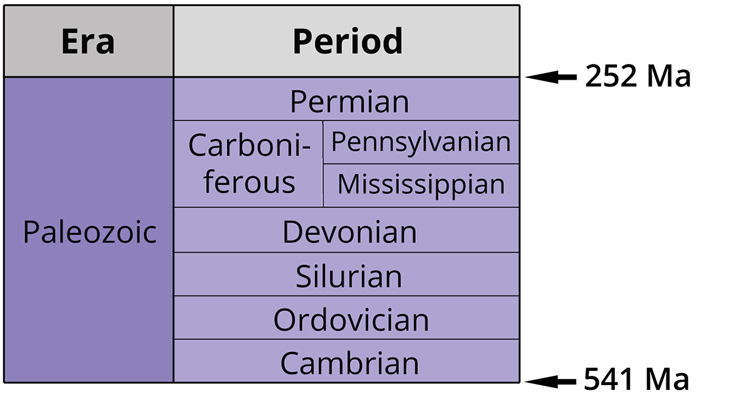
The Mesozoic Era is divided into the Triassic, Jurassic, and Cretaceous periods (Figure \(\PageIndex{5}\)).
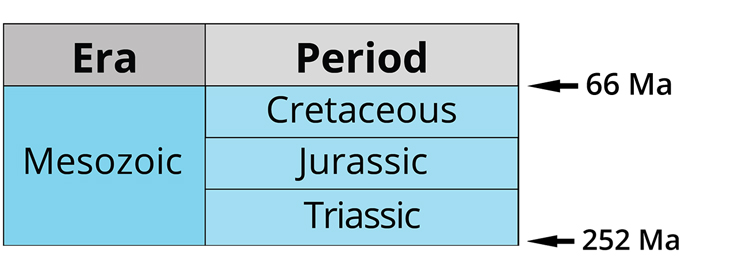
Finally, the Cenozoic Era is divided into three periods: the Paleogene, Neogene, and Quaternary.
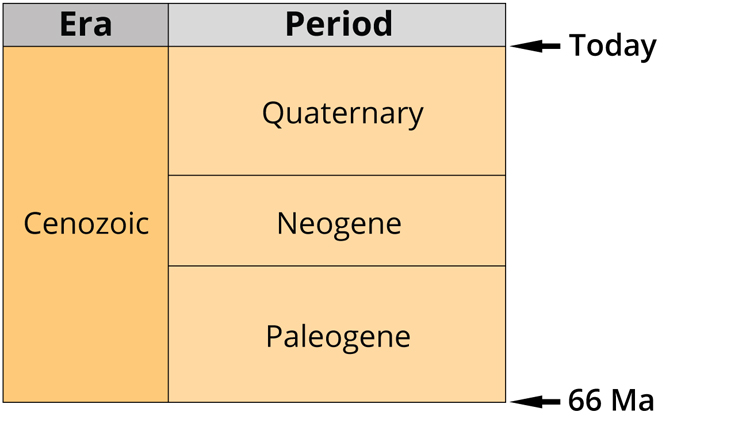
Epochs and Ages
Periods of geological time are subdivided into epochs (Figure \(\PageIndex{7}\)). In turn, Epochs are divided into even narrower units of time called ages. For the sake of simplicity, only the Epochs of the Paleogene, Neogene, and Quaternary periods are considered in this text. It is important to note, however, that all of the periods of the Phanerozoic Era are subdivided into the Epochs and ages.
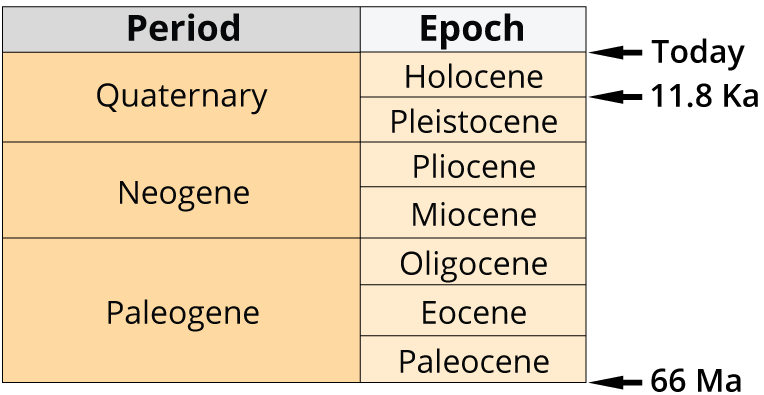
Figure \(\PageIndex{7}\): "Epochs of the Paleogene, Neogene, and Quaternary periods" by Jonathan R. Hendricks, is licensed under CC BY-SA 4.0.The Paleogene Period is divided into–from oldest to youngest–the Paleocene, Eocene, and Oligocene epochs. The Neogene is divided into the Miocene and Pliocene epochs. Finally, the Quaternary is divided into the Pleistocene and Holocene epochs. Some geologists now think that–since humans are having such a notable impact on the Earth and its life–a new, youngest Epoch should be added to the Quaternary: the Anthropocene. There is still considerable discussion in the geological community about whether this Epoch should be added, as well as debate about what characteristics should define its beginning.
Query \(\PageIndex{1}\)
References
- Bentley, C. (2020, January 17). Historical Geology – A free online textbook for Historical Geology courses. OpenGeology. Retrieved June 20, 2023, from https://opengeology.org/historicalgeology/
- Earle, S. (2019). Physical Geology. BCcampus, BC Open Textbook Project.
- Hendricks, J. R. (n.d.). 3. Geological time scale. Digital Atlas of Ancient Life. Retrieved August 4, 2023, from https://www.digitalatlasofancientlife.org/learn/geological-time/geological-time-scale/
- ics-chart. (n.d.). International Commission on Stratigraphy. Retrieved June 20, 2023, from https://stratigraphy.org/timescale/
- Johnson, C., Affolter, M. D., Inkenbrandt, P., & Mosher, C. (2019). An Introduction to Geology. Salt Lake Community College. https://slcc.pressbooks.pub/introgeology/

